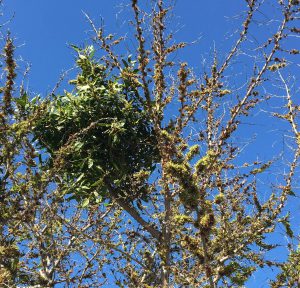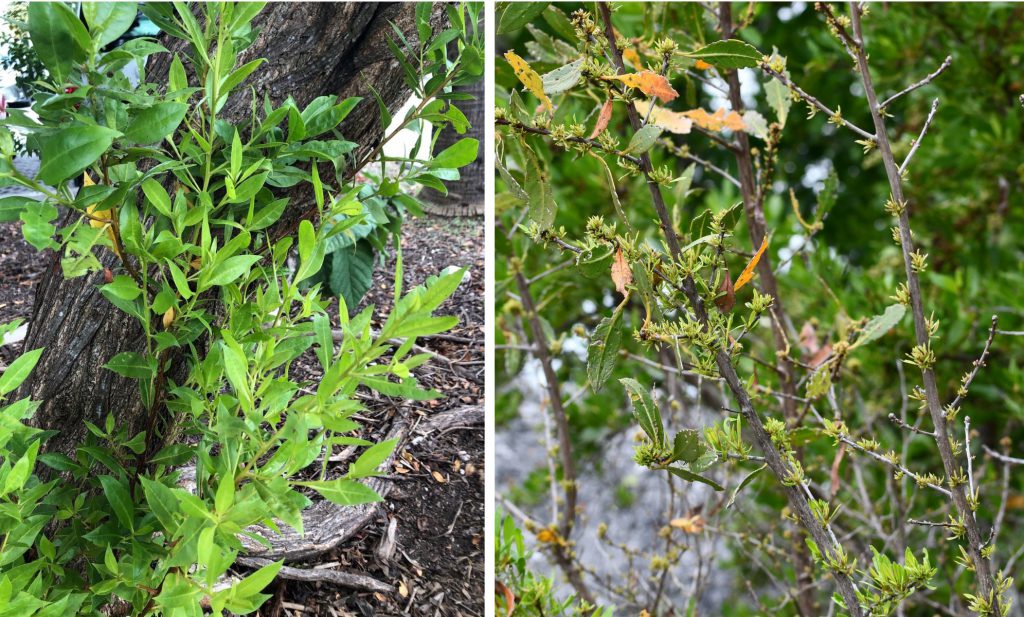
Witch’s broom is a symptom of stress in woody plants that causes deformed or stunted growth on newly expanding buds and leaves. This stress causes the disruption of stem elongation, leaf development and expansion, and can cause a broom-like appearance from the rapid increase in the number of buds erupting, hence the name.
Across the state, this is becoming more of a common problem in the landscape and can be challenging to diagnose. Likewise, here in the Keys, we have seen a steady increase with similar damage to woody plants since 2019. While there are several different environmental stresses that can cause witch’s broom, such as eriophyid mites and certain plant pathogens, overwhelmingly, the damage we see in the Keys is caused by a misuse of herbicides in the chemical class imadizolinone. These herbicides are known as ALS (acetolactase synthase) inhibitors. ALS enzymes are important for plant growth and ALS inhibitor herbicides are taken up through plants roots, where they move through the xylem and phloem, and essentially halt cell growth and division. Minute amounts of these herbicides are causing negative effects on our tropical hardwood trees such as gumbo limbo and buttonwoods. This is because they do not break down quickly in our soil and remain available for uptake by plant roots for several months or longer.

Products that are available for homeowners to purchase at big-box retail stores include RoundUp™ 365, Ortho Groundclear™, and RoundUp™ Extended Control. Some commercial landscape products include Scepter™ T&O and Image™. The active ingredients in this chemical class include imazapyr, imazapic, imazaquin, imazamox, and imazethapyr. The active ingredient in RoundUp™ is glyphosate. Glyphosate is a contact herbicide and is not causing this damage. Damage occurs when these other chemicals are added to RoundUp™ for longer-lasting control and used around plants. The active ingredient of a pesticide is normally required to appear on the front panel of the label (front of package), and this can help homeowners and commercial applicators easily distinguish if one of these active ingredients is included in the herbicide they are purchasing. Although, at first glance, it may seem like the herbicide is being correctly applied since many of these products are labeled for use in graveled areas, driveways, and sidewalks; the label also states they should not be applied within the root zone of desirable plants. Plant roots extend well beyond the canopy of trees. We have even seen damage to trees when herbicide applications are made to adjoining yards or businesses.

If you have a plant or multiple plants that are exhibiting symptoms of witch’s broom, immediately stop using any herbicide products with the active ingredients listed. Repeated use could cause plant death. Plant recovery can take up to a year or longer. In fact, your tree my stop producing new foliage all together. Check to make sure there is still living (green) tissue under the bark by a simple scratch test with your fingernail. If you see green tissue once you scratch some of the bark away, the plant is still alive. Only time will help these trees recover. Do not add any more pesticide products or fertilizers. Keeping detailed records of any pesticides used can help accurately identify problems when they occur.
If you have not applied any herbicide products and still have plants in the landscape exhibiting witch’s broom symptoms, collect a plant sample and contact the Monroe County Extension Service for a plant analysis. When individual branches or small sections of the plants are exhibiting symptoms, prune the damaged parts of the plant and dispose of the material.
For additional information:
Galling Damage to Woody Ornamentals: Diagnosis and Potential Causes https://edis.ifas.ufl.edu/publication/IN1310
 0
0
